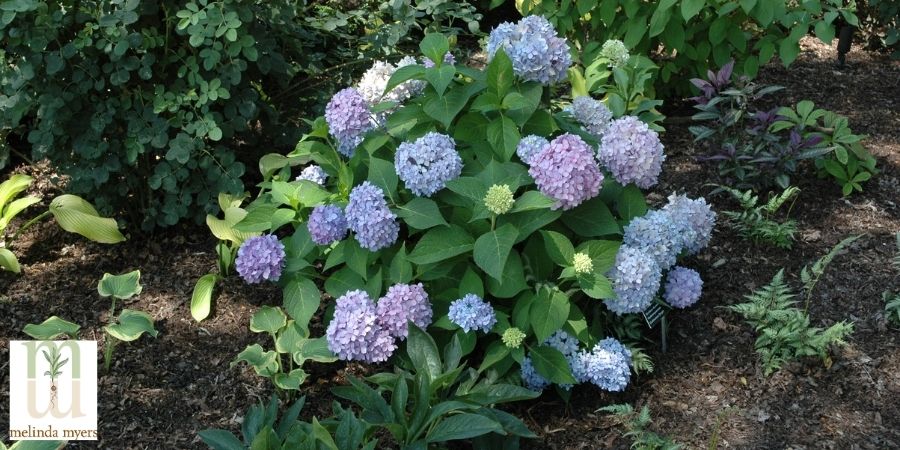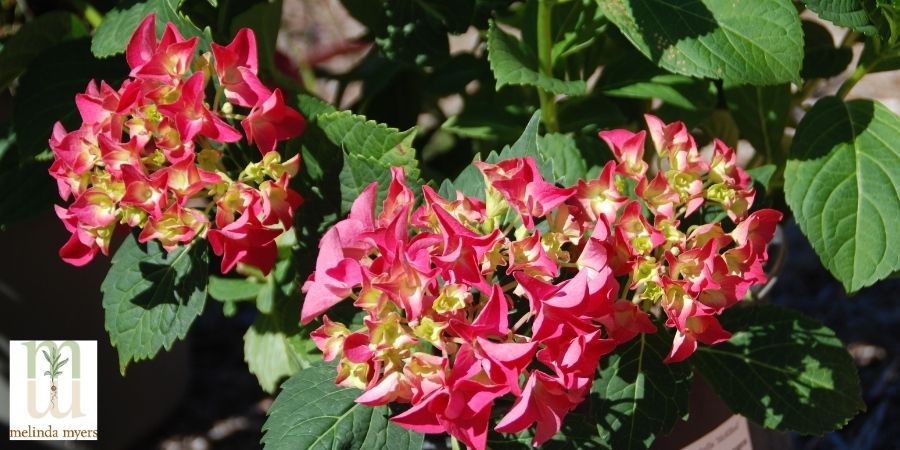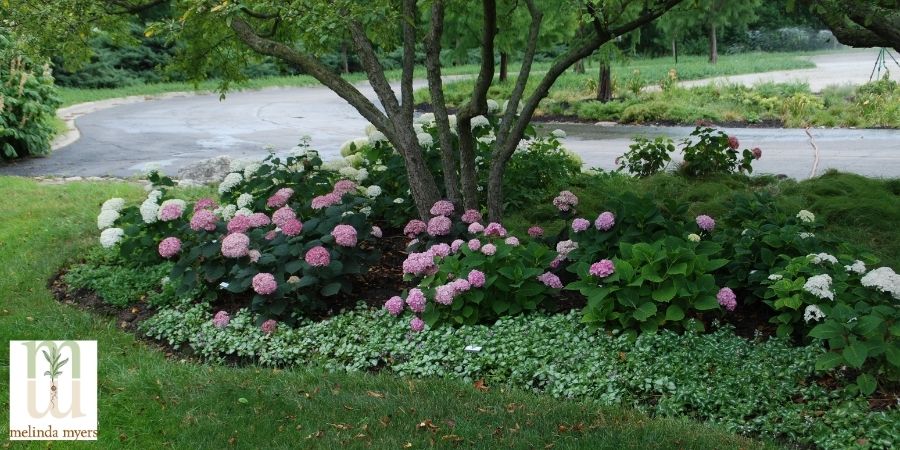What’s Wrong with My Hydrangeas?
- horticulturist and gardening expertMarch 6, 2021
Why Won’t My Hydrangea Bloom?
Let’s start with the bigleaf hydrangeas (Hydrangea macrophylla). These are the beautiful pink or blue-flowered hydrangeas you see thriving in milder climates. They form their flower buds on stems (old wood) the summer prior to flowering. Pruning this type of hydrangea any time other than right after the flowers fade removes the flower buds. Cold winters are also a cause, killing the plant to ground level. The roots survive but all you have are green leaves but no flowers.
The easiest solution for those in zones 5 and colder is to grow panicle or Annabelle-type hydrangeas. These are hardier and form their flower buds the same year they bloom. But as gardeners, we always want to grow the plants we can’t have. Horticulturist Tim Boebel is one of those plant people. He has a pruning, mulching, and fertilization program that has yielded great results for him and others trying to grow bigleaf hydrangeas in the north. Visit his website or read his book Hydrangeas in the North: Getting Blooms in the Colder Climates for a detailed description of his overwintering method, care, and a list of bigleaf varieties he recommends.

Endless Summer
Repeat blooming hydrangeas, like Endless Summer, were introduced to extend the bloom time of bigleaf hydrangeas and allow cold-climate gardeners to enjoy pink or blue hydrangea blooms. These plants flower on old wood as well as new growth. If a cold winter kills the plant back to the ground the new growth is supposed to flower. Many gardeners have been disappointed with the results. I have found that keeping the soil moist, not wet, spring through fall, and applying one application of Milorganite each spring can greatly improve the floral display. Research has found that as the microorganisms release the nutrients from the Milorganite some of the phosphorus and potassium bound to the soil are made available to the plants. Phosphorus helps promote flowering and root development while potassium aids hardiness and disease resistance.
If your neighbors’ bigleaf hydrangeas flower yearly you can’t blame the climate. Make sure you are pruning at the proper time. Fortunately, these plants need minimal pruning. Then check your watering and fertilization regime. A soil test will provide recommendations for how much and what type of fertilizer to use. Avoid over-fertilizing with high nitrogen fertilizers that promote leaf and stem growth and can limit or eliminate flowering. Consider using Milorganite, a low nitrogen slow release fertilizer for your hydrangeas. It provides small amounts of needed nutrients over a longer period of time.
Another common concern is a lack of flowers on recently planted flowering shrubs, including the reliably hardy hydrangeas. These shrubs are usually grown in containers and in full bloom when purchased. They received lots of care at the nursery and the roots fill the pot signally the plant is ready to bloom. Once moved to the garden you may be disappointed when the plant fails to bloom for the next year or two. Be patient. Your shrubs are focusing their energy on establishing a healthy root system. This is good for the plant's longevity but irritates those of us counting on beautiful flowers. Provide proper care, avoid over-fertilization and you will soon be rewarded with a healthy plant and beautiful blossoms.
Annabelle type also called smooth, hydrangeas (Hydrangea arborescens) are those shade tolerant shrubs with large white flowers. Now you can buy pink flowering varieties like Invincibelle® Spirit II. These are hardy in parts of zone 3 to 9 and form their flowers the same year they bloom. Pruning is not a cause of poor flowering. Too much shade or over-fertilization is usually the problem. Adjust care and consider moving the plants to a bit more sunlight if that seems to be the issue.
Panicle hydrangeas have become very popular due to their hardiness, easy-care nature, variety of available sizes, and reliable flowering. Their flower buds, like Annabelle’s, form the same season they bloom. The white cone-shaped flowers fade to pink or red and then brown. These prefer full sun and are drought tolerant once established. Provide the needed growing conditions and avoid over-fertilizing with excess nitrogen and you will be rewarded with flowers each year.

Grateful Red
Hydrangea Has Droopy Leaves, Blooms, and Stems
If your plants are flowering but won’t stand tall you can blame it on the weather. Warm temperatures, not extreme heat, and moisture promote lush growth. These stems are often not strong enough to support the large hydrangea blooms. We can’t change the weather but we can make sure we water, fertilize and prune properly.
Hydrangeas do benefit from regular fertilization but too much, especially from high nitrogen fertilizer, can promote lush growth that may not be able to support the blooms. Building healthy soil with compost and organic mulches promotes strong growth. Milorganite contains 85% organic matter so it feeds the soil as well as the plants.
Improper pruning not only interferes with flowering on some hydrangeas it can cause poor growth on most. Annabelle types are a perfect example. When you cut all the stems back to the ground fall through early spring, they tend to grow extra long often weak stems. Instead cut all the stems back 15-18” in late winter. Then prune half of these to ground level. The older stems help provide support for the new growth reducing the risk of floppy growth. When buying new plants look for varieties noted for strong stems that support the large flowers.
Panicle hydrangeas need minimal pruning. When pruned too severely the resulting growth is weak and can’t support the large flowers. Try thinning plants to 5 to 10 primary shoots if you feel you need to encourage more blooms. Check out the YouTube Video from Proven Winners to see how it’s done. Better yet, select the variety that fits the space so minimal pruning will be needed. You will save yourself some work and frustration.
A lack of water results in droopy leaves and stems. This is a common problem with new plantings of container-grown shrubs. These plants were raised in soilless mixes that provide great drainage but do not retain water as long as most garden soils. To avoid overwatering your new plantings check the soil near the plant and in the surrounding garden soil. The first few years you may be watering the original root area more often than the surrounding soil. Once those roots grow into the garden soil this will be less of an issue. Just be careful not to overwater the garden soil that can lead to poor rooting, rot, and death of your plant.
Hydrangea Flowers Do Not Last Long
Hotter than normal temperatures and dry soil can quickly turn hydrangea blooms to brown. Adjust your watering routine as needed since the soil tends to dry more quickly as the temperatures climb. Continue to water thoroughly encouraging deep more drought-tolerant roots. Check the soil and wait until the top few inches are crumbly but slightly moist to water. Avoid frequent shallow watering that encourages roots to grow near the surface. These dry out more quickly so you will need to water more often just to keep your plants alive. Mulch the soil with leaves, woodchips, or shredded bark. A layer of organic mulch helps conserve moisture, keep the soil a bit cooler, and improves the soil as it decomposes.

Hydrangeas as ground cover
Hydrangea has Holes, Disfigured and Disappearing leaves
Japanese beetles feed on hundreds of different plants including panicle and oakleaf hydrangeas. Their feeding results in a lacy appearance of the leaves. Some gardeners choose to tolerate the damage while others don’t. Knocking them into a can of soapy water is a non-chemical option. A colleague uses a battery-powered small hand vacuum to capture the insects then drops them into the soapy water. Seems like you can capture more in less time. Just be sure to empty the contents before stowing the vacuum.
BeetleGone® is an organic insecticide that controls adult beetles. The active ingredient is a specific strain of a naturally occurring soil bacteria (Bacillus thuringiensis galleriae). It kills the adults without harming bees, butterflies, and other pollinators.
Aphids are tear-dropped-shaped insects that suck plant juices. They excrete the excess as a clear sticky substance called honeydew. A strong blast of water may be enough to knock them to the ground. If the pests remain try an organic control such as insecticidal soap or a lightweight horticulture oil like Summit Year-Round Spray Oil.
As always read and follow label directions whenever using any organic, natural, or synthetic product. You’ll keep yourself safe, achieve better results and avoid damage to the plants.
If leaves and portions of the stem disappear, deer are likely the culprit. Five feet tall fencing around small gardens will protect your plants from these hungry critters. You may decide this is not a practical or aesthetically pleasing option. Scare tactics may work but urban and suburban wildlife do not scare easily, especially when they are hungry. One horticulturist used colorful wine bottles inverted over metal stakes. As the wind blew, the bottles clanged and helped keep the deer away. Animal repellents are another option. Treat plants before animals start feeding for better results. Check the repellent label for plants that can be treated, animals the product repels, and when to reapply. Consider an organic rain and snow-resistant product that requires fewer applications saving you time and money.
Despite the challenges, the beauty hydrangeas add to the landscape make them one of the more popular shrubs. Reduce maintenance and increase your success by selecting the right hydrangea for your climate, growing conditions, and gardening style. You’ll be rewarded with healthy flowering shrubs for your gardens, mixed borders, and hedges.

